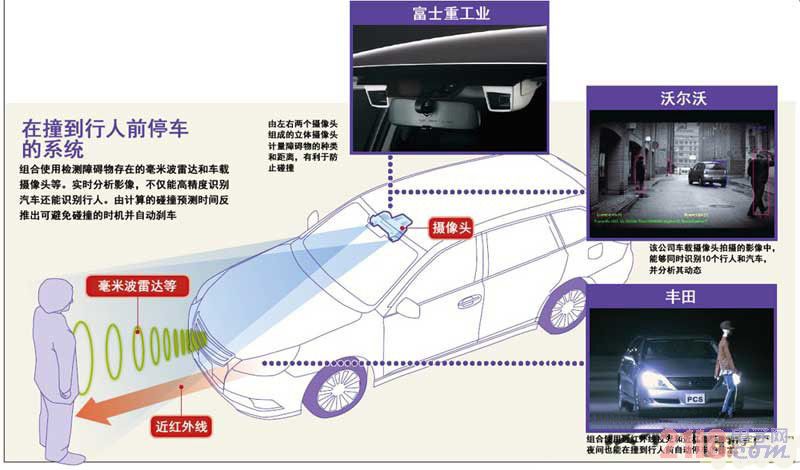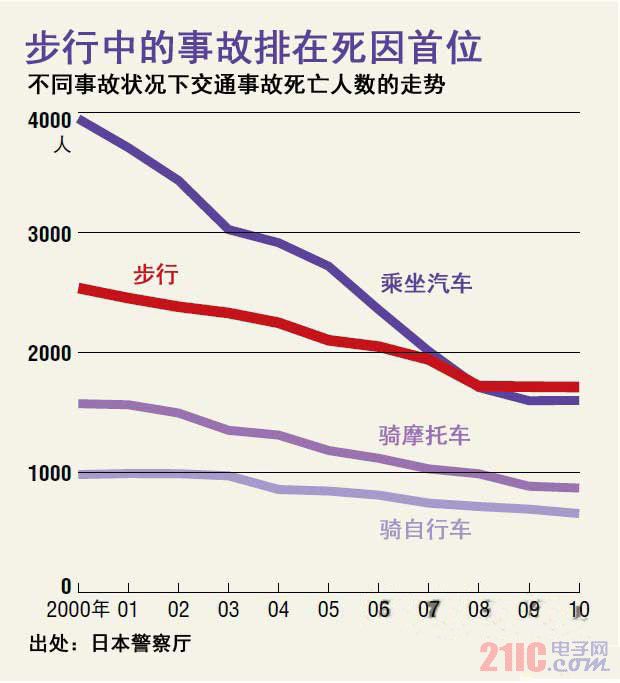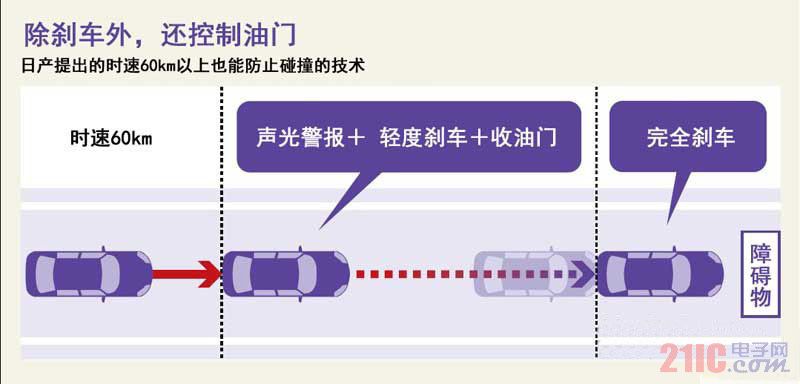Automakers have begun to challenge the "original sin" of cars. Anti-collision technologies aimed at achieving "zero collision accidents" have been put into use one after another. This system can be installed on a car at a low price of about 10 yen, and the nighttime anti-collision measures that were once weak have also been improved.
This article refers to the address: http://
"Turn down the air conditioning temperature." The driver adjusts the temperature of the air conditioner during driving. When the line of sight turns back, he sees the pedestrian coming over and catches the emergency brake. This kind of scary cold sweat scene has been experienced by people who have driven cars.
All car manufacturers are currently actively preventing traffic accidents. Alan Desselss, president of the Swedish corporation Volvo's Japanese corporation, said: "Strive to achieve zero deaths in traffic accidents in 2020." Nissan also proposed to halve the death penalty in 2015 and eventually reduce it to zero by 2015.
A traffic accident can be said to be the "original sin" of a car manufacturer. Of course, the accident is basically caused by the driver's negligence. Although automakers are improving vehicle safety, reducing traffic accidents and the number of deaths caused. However, the fact that the collision incident still occurs cannot be denied.
Technology that is expected to prevent traffic accidents has come out. According to data from the Japanese National Police Agency, among the number of people killed in traffic accidents in 2010, pedestrians ranked first. Now, pedestrians can be identified, and the collision avoidance system that automatically stops before the collision has begun commercialization.
Japan’s first commercial anti-collision system is “EyeSight (ver. 2)†from Fuji Heavy Industries. In May 2010, it was just sold as the main component of the "Lie Lion" option, and the assembly rate accounted for more than 70% of the new car sales.
100,000 yen anti-collision system

EyeSight is implemented by a module that integrates a stereo camera with two left and right cameras, an image processing semiconductor, and a semiconductor for vehicle control. Set on the top of the front window.
First, in contrast to the image of the left and right stereo camera, the left and right deviation of the shooting angle may cause the pixel position to be deviated. Based on the deviation, the distance between the car and obstacles such as cars and pedestrians is calculated. The collision prediction time of hitting an obstacle is inferred based on the distance and the speed difference between the car and the obstacle.
During driving, the car is getting closer and closer to the obstacle. About 3 seconds before the collision prediction time, the system flashes the sound and the indicator light to evoke the driver's attention. Even so, when the driver did not brake and the steering wheel took the avoidance behavior, the system braked lightly about 2 seconds ago. Also remind the rear vehicle by turning on the brake light.

About 1 second before the collision, the system completely brakes to stop before the collision. According to reports, collisions can be prevented under conditions such as dry road surface, four-person ride, and a speed of 30 km or less.
The system analyzes the image of the stereo camera in an instant and treats the person as an obstacle.
In the development process, the director of the electronic product design department of the Subaru Technology Division, which was developed by EyeSight, pointed out that “the car has a clear outline and features, so it is easy to recognize automatically, and pedestrians are difficult to identify because of the relationship between clothing and movement. To accurately identify pedestrians, We drove a few kilometers of Earth's distance and accumulated pedestrian data."
However, you should not rely too much on the system. In the case of slippery road surface and tire wear, it is sometimes difficult to completely prevent collision. The gateway explained: "EyeSight should be used as the last method to prevent collisions."
The main reason for the popularity of EyeSight is the low price, only 100,000 yen. In the past, the car used to measure the distance from the obstacle in front, and used an expensive component such as a millimeter-wave radar and a camera. The sales price was several hundred thousand yen or more. Fuji Heavy Industries has achieved this function with only stereo cameras and components.
In fact, the key to anti-collision systems – the technique of measuring distances from obstacles ahead – has long been established. And it has already been adopted in high-end cars and other models, and no abnormalities have been found. So why is EyeSight the first anti-collision system in Japan?
The reason is the safety policy set by the Ministry of Land, Infrastructure, Transport and Tourism.

Prior to 2009, the use of automatic braking systems to brake before collision was not permitted in Japan. The automatic braking system is only allowed to reduce the damage after a collision. Although the system was not based on the driver's judgment of the operation and explained to what extent the automatic control was allowed, the limitations of the system were later relaxed.
Japan’s first car that allows the use of anti-collision systems is not a domestic car but Volvo. Volvo negotiated with the Ministry of Land, Infrastructure, Transport and Tourism in Japan, and the "XC60", which was launched in Japan in August 2009, is equipped with a "City Safety" function that can prevent rear-end vehicles from chasing after a speed of 15km or less. The reason for the approval seems to be that the XC60 was listed overseas in 2008 and accumulated a lot of application data.
Identify 10 pedestrians at the same time
Volvo also launched the "HUMAN SAFETY" option in March this year. A combination of a millimeter-wave radar and a single-lens camera capable of measuring a distance of 180m is used to detect the car and pedestrians and automatically brake to prevent collision. Mr. Shui Gukang, manager of customer service department of Volvo Cars Japan, said: "The system recognizes 10 pedestrians at the same time. By judging each person's behavior, if it is considered dangerous, it will start the alarm and automatic braking system 2 seconds ago." According to reports, the system can prevent collisions at speeds of up to 35 km/h.
The sales price of HUMAN SAFETY is 250,000 yen. However, Volvo has offered a discount on the additional cost of HUMAN SAFETY from July to 100,000 yen. The market price of the collision avoidance system will stabilize at approximately 100,000 yen.
Both EyeSight and HUMAN SAFETY have weaknesses in pedestrian detection. Since the captured image is used to identify pedestrians, the recognition performance is degraded under adverse conditions such as insufficient light at night.
If you drive with a high beam at night, you can reach the pedestrian's body at a distance of about 50m. From this point of view, it is easy to use the system to prevent collisions, but it is unrealistic to consider the problem that the high beam lights enter the oncoming driver's field of view. In July of this year, Toyota proposed a solution to this. Toyota publicly demonstrated the safety technology of using near-infrared and near-infrared stereo cameras that are invisible to the naked eye. This technology also recognizes pedestrians who are about 50m away from the high beam.
The anti-collision system will be further improved. For example, Toyota is still using the technology of image recognition technology to develop a turn and pay attention to the technology of braking when the bumper hits the guardrail.
Technologies that support high-speed driving and prevent collisions in a natural way are also constantly evolving. Nissan is developing a system that can prevent cars from colliding at a speed of 60km per hour.
The idea of ​​first light braking and then full braking is the same as EyeSight. However, the system started 6 seconds before the collision prediction time, earlier than EyeSight. It is characterized by a slight brake and an alarm when the throttle is closed. If the throttle is not closed, it is regarded as the driver does not decelerate and the steering wheel is operated to prevent collision, and the anti-collision system does not start. If the throttle is closed, the automatic brake will be activated.
German Volkswagen released a new compact car "up!" for the European market in August. For the first time, a low-priced, compact car can be used as an option to select an anti-collision system.
Industry stakeholders explained that the reason is "the difference between auto insurance systems in Europe and Japan." European and American insurance companies have reduced the premiums of cars equipped with anti-collision systems due to accidents.
If Japan has such an environment, it will benefit more and more from the anti-collision system.
We are the leading and innovative manufacturer with professional research and development capacity in China.Now the product cover Micro USB to USB,
micro USB Connector,Micro USB 2.0 Cable. Etc.
Product information
This Micro USB data cable can be connected to all the smart devices with MICRO interface to your computer USB port for sync and charging .
Data cable for synchronizing and recharging your phone
USB 2.0-compatible port
Data synchronization
Charges phone from your computer
Charges phone from a USB charger
Compatible with phones with a MICRO USB connector
Micro USB Cable, Micro USB to USB, USB Connector, Micro USB 2.0 Cable
Hebei Baisiwei Import&Export Trade Co., LTD. , https://www.baisiweicable.com